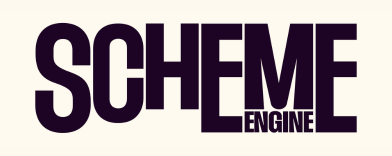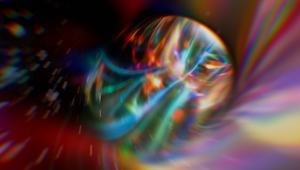
Overstimulating Your Senses with Mind-Warping Humour in 5 Gum Ad Reboot

If you grew up in the 2000s, you’ll remember the phrase ‘How It Feels to Chew 5 Gum’ – not just for the BBDO ad campaign for Wrigley’s 5 Gum, but also the countless meme videos it spawned.
Directed by Dante Ariola, the original films for the four different flavours of gum were a blend of dystopian, sci-fi surrealism, concrete-clad with cool, metal contraptions designed to ‘Stimulate Your Senses’. Now, BBDO New York is bringing the campaign up-to-date for a new hyper-online generation with ‘Overstimulate Your Senses’, employing the mind-bending animation skills of Hornet directors Jay & Jin.
Two of the ads, ‘Cobalt’ and ‘Prism’ were launched this week, with two more to follow in June.
“A big part of shaping the campaign came from understanding that a huge part of the audience was born after the original spots aired,” the duo tells LBB. “They have no built-in nostalgia, so we had to meet them where they are now. That meant really tuning into how they consume content, how fast their attention moves, and what makes them laugh.
“We spent time digging into internet humour – the kind that feels chaotic and spontaneous but actually follows its own kind of logic. That energy shaped a lot of the pacing, the tone, and even how we approached timing in the visuals. Everything had to grab you right away but still leave room for surprise.”
BBDO New York’s brief provided a clear narrative but left plenty of room for Jay & Jin to experiment visually. The big decisions boiled down to how much this hyper-digital humour would influence the aesthetic, and how far they’d stray stylistically from the “darker, grittier” original ads. In the end, the approach took a lot of inspiration from the cinematic ‘Stimulate Your Senses’ films, especially with the distinct personalities for each flavour, but added a fresher, more vibrant tone for a modern audience.
“The visual cohesion across different flavours was something we really admired. When it came out, the work felt incredibly fresh and ahead of its time… What we tried to carry forward was that same instinct to push visuals in unexpected ways while staying connected to the current aesthetic.
“We started by really trying to understand the uniqueness of each flavour and what kind of sensorial experience it was trying to evoke,” they explain. “That became the foundation for everything that followed. From there we moved into storyboarding, translating the scripts into visuals while simultaneously developing the worlds and characters. That parallel process helped us find connections early on and let the design language grow in a cohesive way.”
The visual approach was also informed by the metahumans Jay & Jin were using in Unreal Engine, utilising their slightly uncanny appearance to inspire visuals that straddled the line between reality and a stylish, synthetic look. The team explored a wide range of hand-drawn variations for objects and environments, and added details to each digital set with deliberate intent. “Colour also played a huge role,” they add. “The colourkey process was introduced early to define a distinct palette for each spot and let that guide the mood throughout production.”

Once they were happy with the designs and storyboards, they moved to pre-vis and nailed down the first stage of the 3D workflow – the geometry, basic animation, and early camera blocking – before letting the artists and animators bring everything to life. “They hand-painted textures, sculpted environments, fine-tuned animation, and lit the scenes in a way that really captured the mood of each flavour. We paid a lot of attention to the animation, making sure every moment carried a bit of personality and surprise.
“After that, sound design came in to elevate everything. Our sound team layered in detail that added rhythm and depth to the worlds, and finally our compositors stitched it all together into the final image.”
Similar to the original films, Jay & Jin were keen to create an atmosphere that was almost otherworldly, in order to prompt curiosity in the audience. And on top of that, they needed each film, for each of the four different flavours, to feel both distinct and consistent. “That thinking is really what brought in the sci-fi influence,” they explain. “It gave us a language to connect everything visually. Even though each flavour has its own vibe and energy, we used sci-fi styling to connect them together. That came through in the lighting, the materials, and sound which leaned toward something more synthetic and tech-inspired.”
The other main challenge was to pack all of this intricate design work meaningfully into a short 15-second window. With such an exciting playground of visual opportunities, this meant tough decisions had to be made to leave some ideas on the cutting room floor. “There were moments when we fell in love with a certain detail, or a design element, but we had to ask ourselves if it really served the piece as a whole. What helped was stepping back and looking at the entire spot as one rhythm, one feeling, rather than getting caught up in the shot-by-shot breakdown.

“It taught us to not get too attached to anything just because it looked cool. If it did not help the flow or the emotion of the story, we let it go. That was hardest for us, but it also made the final piece feel more intentional and clear.”
But above all, what really pulls the whole thing together for the directing duo is the rebooted campaign’s overall energy – the fast pace, playful chaos and little twists and surprises that make the expertly-crafted designs burst with overstimulating flavour. “We had a lot of fun adding small hidden details, like the alien character in Ricky’s photo with his grandpa, or the spaceship secretly being his water jug. Those little moments add personality and make the worlds feel lived-in.
“We just hope that mix of care, humour and a bit of weirdness leaves something that sticks with people.”















